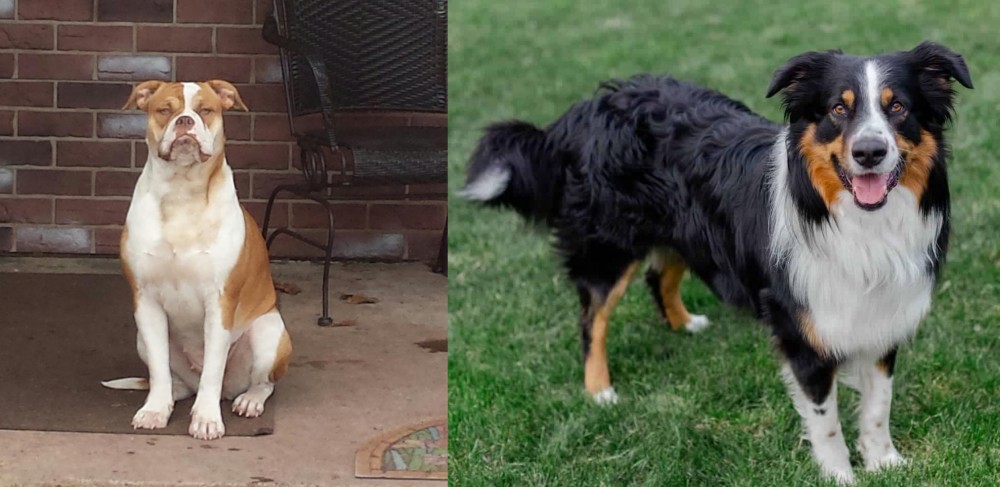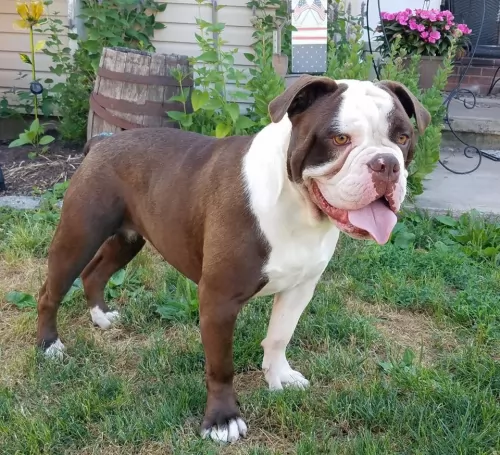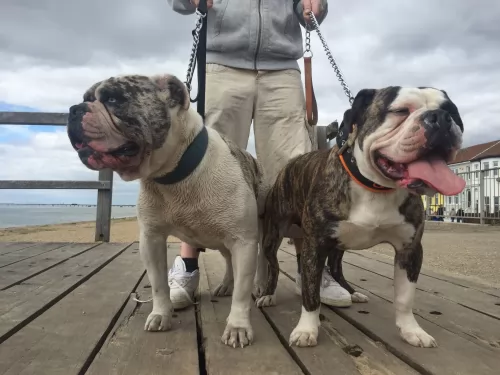 Petzlover
Petzlover Both Alapaha Blue Blood Bulldog and English Shepherd are originated from United States. Both Alapaha Blue Blood Bulldog and English Shepherd are having almost same height. Alapaha Blue Blood Bulldog may weigh 19 kg / 42 pounds more than English Shepherd. Both Alapaha Blue Blood Bulldog and English Shepherd has same life span. Both Alapaha Blue Blood Bulldog and English Shepherd has same litter size. Alapaha Blue Blood Bulldog requires Moderate Maintenance. But English Shepherd requires Low Maintenance
Both Alapaha Blue Blood Bulldog and English Shepherd are originated from United States. Both Alapaha Blue Blood Bulldog and English Shepherd are having almost same height. Alapaha Blue Blood Bulldog may weigh 19 kg / 42 pounds more than English Shepherd. Both Alapaha Blue Blood Bulldog and English Shepherd has same life span. Both Alapaha Blue Blood Bulldog and English Shepherd has same litter size. Alapaha Blue Blood Bulldog requires Moderate Maintenance. But English Shepherd requires Low Maintenance
 Alapaha has a very interesting history. Their origin dates from one family that lived near Alapaha river in Georgia, in the USA 200 years ago. The family rescued dying breed of Plantation Bulldog. They actually had this breed for 80 years and every dog was named Otto. This breed was not just saved, but the family created a perfect guard dog. Alapaha Blue Blood Bulldog started to expand and by 1980s they spread through the country.
Alapaha has a very interesting history. Their origin dates from one family that lived near Alapaha river in Georgia, in the USA 200 years ago. The family rescued dying breed of Plantation Bulldog. They actually had this breed for 80 years and every dog was named Otto. This breed was not just saved, but the family created a perfect guard dog. Alapaha Blue Blood Bulldog started to expand and by 1980s they spread through the country.
 The English Shepherd is another dog with an English name that was developed in the United States. They developed from British farm dogs that were brought to the United States in the 17th, 18th and 19th centuries by the Scottish and English as they settled in the New World. Tracing their line through working dogs and collies in Scotland and northern England, the settlers bred them with local dogs and each other. These working farm dogs were called English Shepherds, Scotch Collies, barnyard collie, farm shepherd, the cow dog, and the old fashioned shepherd.
The English Shepherd is another dog with an English name that was developed in the United States. They developed from British farm dogs that were brought to the United States in the 17th, 18th and 19th centuries by the Scottish and English as they settled in the New World. Tracing their line through working dogs and collies in Scotland and northern England, the settlers bred them with local dogs and each other. These working farm dogs were called English Shepherds, Scotch Collies, barnyard collie, farm shepherd, the cow dog, and the old fashioned shepherd.
The English Shepherd was appreciated by the settlers and farmers because he was a versatile dog that could herd their flocks and protect their homes as well. They appreciated his intelligence and ability to hunt vermin and be a companion for their children. English Shepherds were bred to work with a variety of livestock such as pigs, cattle, goats, sheep and fowl. They were used to hunt as well and were known to track racoons and squirrels and tree them. There wasn’t a more popular dog in the American Midwest and East in the 1800’s and 1900’s.
The breed is trustworthy, alert and independent. As the small family farms were replaced by large agricultural enterprises the English Shepherd’s numbers dwindled as well until he fell into the category of a rare breed. There were no clubs to support it and not AKC recognition. The UKC had a different dog registered as a farm shepherd.
Today’s English Shepherd is still a farm dog, but he also hunts, is a therapy dog, competes in AKC trials, and performs search and rescue duties. As a farm dog, they are still the most desirable due to their versatility in working with different livestock, guarding the home and caring for the children. They do these things in a gentle way if possible but can be tough if needed. They have great empathy for the livestock and for their human family. This makes him a great dog for the family. The English Shepherd has remained a farm dog, working dog more than a show dog, over all these years.
 Alapaha Blue Blood Bulldog height is approximately 61 cm, while their weight variates from 34-47kg. Have in mind that females are slightly smaller than males.
Alapaha Blue Blood Bulldog height is approximately 61 cm, while their weight variates from 34-47kg. Have in mind that females are slightly smaller than males.
A lifespan of Alapaha Blue Blood Bulldog is approximately 11-13 years, but it depends from dog to dog, and with proper care, they can live much longer.
Litter Size of this breed depends but average is 4-8 puppies.
Other Names for Alapaha Blue Blood Bulldogs are Alapaha, Otto, Otto Bulldog.
 The American bred English Shepherd is a medium sized dog that looks somewhat like an Australian Shepherd or Border Collie. They have tails, never come in merle coloring and their head is not as rounded as the Australian Shepherd. A working dog, its proportionally very well balanced. Because the English Shepherd is so popular across the country, doing a wide variety of jobs, there is some regional differences in the dogs.
The American bred English Shepherd is a medium sized dog that looks somewhat like an Australian Shepherd or Border Collie. They have tails, never come in merle coloring and their head is not as rounded as the Australian Shepherd. A working dog, its proportionally very well balanced. Because the English Shepherd is so popular across the country, doing a wide variety of jobs, there is some regional differences in the dogs.
The coat can be curly or straight with feathering around the tail, ears and legs. Their heads are slightly rounded but broad and the muzzle is also broad with a solid black nose except for the clear sable dogs whose nose is brown. The eyes show you how intelligent and strong this breed is, and they should be round, brown and oblique. The ears are close to the head and wide apart.
With a strong, muscular back and shoulders the English Shepherd can do almost anything you ask him to. His legs are strong and straight, and his hind legs are muscular. His feet are compact, oval and well padded.
 Alapaha breed is not just beautiful and unique breed, but they are also great family dogs. They are very loyal, but also very protective and sometimes possessive. Alapaha will require a lot of attention. It is very important to train your dog properly from the early age. A steady and firm hand is important so if you are first time owner, consider having this breed twice. You should not punish your dog, or implement any types of old-fashioned way of training. They do not respond well to that. Overall, they are very smart and quick learners. Alapaha needs to be socialized with other animals from the early age. They can be aggressive towards dogs that they don’t know. At first, you can train them around the house with family and friends, and after the puppy receives all the vaccines, you can start with socialization with other dogs. If you are first time owner and you want this beautiful breed, you should advise with more experienced breed owner. They simply have more experience than you and they know and understand the puppies, so you will receive more accurate advice. Have in mind that every dog has its own personality. Overall, if you train your dog properly you will have a happy and healthy dog that will be amazing with other animals and especially family members.
Alapaha breed is not just beautiful and unique breed, but they are also great family dogs. They are very loyal, but also very protective and sometimes possessive. Alapaha will require a lot of attention. It is very important to train your dog properly from the early age. A steady and firm hand is important so if you are first time owner, consider having this breed twice. You should not punish your dog, or implement any types of old-fashioned way of training. They do not respond well to that. Overall, they are very smart and quick learners. Alapaha needs to be socialized with other animals from the early age. They can be aggressive towards dogs that they don’t know. At first, you can train them around the house with family and friends, and after the puppy receives all the vaccines, you can start with socialization with other dogs. If you are first time owner and you want this beautiful breed, you should advise with more experienced breed owner. They simply have more experience than you and they know and understand the puppies, so you will receive more accurate advice. Have in mind that every dog has its own personality. Overall, if you train your dog properly you will have a happy and healthy dog that will be amazing with other animals and especially family members.
 It may seem strange to talk about kindness in a working dog, but it is one of the defining traits of the English Shepherd, along with intelligence. The breed is extremely kind to everyone he lives with animals and people. Once he is secure in his job and takes in his children or his herd, he is one of the best caretakers around. He is an independent thinker, is easily trained, and highly affectionate. However, he does see himself as the boss and unless you establish yourself in that alpha role you could have problems.
It may seem strange to talk about kindness in a working dog, but it is one of the defining traits of the English Shepherd, along with intelligence. The breed is extremely kind to everyone he lives with animals and people. Once he is secure in his job and takes in his children or his herd, he is one of the best caretakers around. He is an independent thinker, is easily trained, and highly affectionate. However, he does see himself as the boss and unless you establish yourself in that alpha role you could have problems.
 Almost every breed has health issues. That doesn’t mean that your dog will have the same health problems that are typical of the breed. If you choose puppy carefully, from the right breed owners, and if you take them to the regular vet checks with proper diet, most likely that you won’t be having any problems. Alapaha’s usual health problems are hip dysplasia, congenital deafness, entropion- this is an eye related problem, and sometimes they can have skin problems too. Again have in mind that this breed is very healthy and they do not have as many problems as regular bulldogs. The best way to protect yourself from getting a sick dog, you can require tests from the breed owners. If they are reluctant to do that, or they are assuring you that they have healthy dogs, have in mind that something is probably wrong. It is the best to choose a puppy with someone who has more experience with this breed.
Almost every breed has health issues. That doesn’t mean that your dog will have the same health problems that are typical of the breed. If you choose puppy carefully, from the right breed owners, and if you take them to the regular vet checks with proper diet, most likely that you won’t be having any problems. Alapaha’s usual health problems are hip dysplasia, congenital deafness, entropion- this is an eye related problem, and sometimes they can have skin problems too. Again have in mind that this breed is very healthy and they do not have as many problems as regular bulldogs. The best way to protect yourself from getting a sick dog, you can require tests from the breed owners. If they are reluctant to do that, or they are assuring you that they have healthy dogs, have in mind that something is probably wrong. It is the best to choose a puppy with someone who has more experience with this breed.
 Like many other herding breeds, it has been found that about 15% of English Shepherds had a gene mutation called MDR1. This means they have adverse reaction and high sensitivity to many common drugs for dogs. This condition could be life-threatening so test your dog for it and know what you are up against.
Like many other herding breeds, it has been found that about 15% of English Shepherds had a gene mutation called MDR1. This means they have adverse reaction and high sensitivity to many common drugs for dogs. This condition could be life-threatening so test your dog for it and know what you are up against.
 Feeding of this breed variates on the size of the dog and activity. If your dog is big and very active, you will have to feed it more. Overall, 2-4 cups of high-quality dry food would be enough. It is the best if you divide that into 2 meals per day.
Feeding of this breed variates on the size of the dog and activity. If your dog is big and very active, you will have to feed it more. Overall, 2-4 cups of high-quality dry food would be enough. It is the best if you divide that into 2 meals per day.
If you have a puppy, it is the best to feed it 3-5 times per day in smaller portions. That is the best way to develop your dog into a healthy and happy adult. In the first year, you should feed your dog this way.
Grooming Alapaha dog is very easy actually. They have a short coat, so occasional grooming is all that this breed needs. Of course, you can bath your dog when gets dirty, but not too often. With occasional bath and semi-regular brushing, you will have a perfectly clean dog.
 Remember the English Shepherd is a hard working dog. But if you don’t work him don’t overfeed him. Twice a day, he needs about one half cup of a good quality dry food made with an active, medium sized dog in mind.
Remember the English Shepherd is a hard working dog. But if you don’t work him don’t overfeed him. Twice a day, he needs about one half cup of a good quality dry food made with an active, medium sized dog in mind.
In addition to the health concern listed above, the English Shepherd is also prone to:
Both elbow and hip dysplasia can plaque the English Shepherd as it does almost any active breed. Have your puppy tested as it can cause lameness and arthritis.
This is a herding breed and they need exercise. They need a job. They are intelligent and work oriented so make sure they have something to do. Take them to herding trails and have their herding instinct tested. Put them to work in flyball, agility, frisbee, tracking, obedience, rally, herding and showmanship events. Just make sure your English Shepherd has enough to keep his mind and body stimulated at a high rate every day.